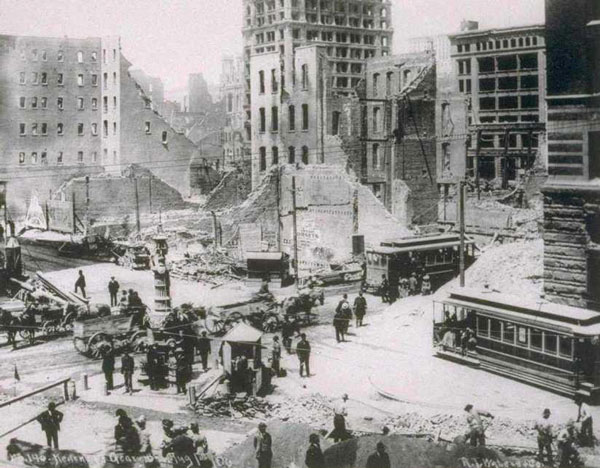Looking back at the 10 worst natural disasters in American history
While Super Typhoon Sandy just ravaged the United States, look back at the worst natural disasters in this country's history.
10. Storm Galveston
Galveston storm landed on Galveston - the island was named 'The Jewel of Texas' on September 8, 1900. This was once a cotton trading center and Texas' largest city. However, a Category 4 storm with a wind speed of 135 miles per hour landed early in the morning to sweep the buildings under the power of waves of up to 15 feet. An estimated 8,000 people were killed. Although the city was later rebuilt successfully, it never regained its prosperity as before 'New York of the South' .
9. Hurricane Katrina - August 29, 2005
Katrina - the Atlantic storm began just a level storm when it blew across southern Florida, then it became America's most costly and deadly tragedy. Katrina landed on the Louisiana coast with winds of up to 125 mph, breaking the dyke protecting New Orleans and submerging 80% of the city. Katrina killed at least 1,836 people and caused an estimated $ 125 billion in damage.
8. Dust storms in the early 1930s
In the early 1930s, the Great Plains was a farmer's paradise. Increasing demand for wheat has prompted farmers to settle in the grasslands of the southern plains. However, erosion has occurred. The roots of plants have the effect of moisturizing the soil and are replaced by plants. A long decade of drought has turned the surface soil into dust, stormy winds swept this dust up and blew eastward, darkening the Atlantic coast. Without crops, a third of the farmers had to live on government subsidies and about half a million Americans were homeless.
7. Fires and earthquakes in San Francisco - April 18, 1906

San Francisco residents were suddenly awakened on a spring morning by an earthquake that lasted more than a minute but subsequent events caused the city to burn for four days straight. The 7.7 and 7.9 magnitude earthquakes broke natural gas pipelines that caused fires. The water pipes were also destroyed, making it difficult to fire fire. The fire was then extinguished, but it burned down 500 blocks and 3,000 people were killed. Of the survivors, about 225,000 were left homeless.
6. Hurricane Okeechobee - September 16, 1928
Evacue residents from the Okeechobee lake area returned home when they received information that the storms did not come as expected. However, the storm landed on September 16 with winds of up to 140 mph. It broke the dyke south of the lake and caused floods that killed 2,500 people.
5. Hot sunshine - summer of 1980
1980 was one of America's most catastrophic events. A high pressure ridge pushed temperatures across central and southern United States over 90 degrees Fahrenheit (degree F) at the hottest time of the summer. Agricultural damage is estimated at US $ 48 billion due to a major drought, and 10,000 people die from heat and other heat-related diseases.
4. Heat wave in the summer of 1988

A year of prolonged drought ravaged America's agricultural economy. Damage to the agricultural economy has exceeded 61 billion USD. The total amount of rainfall along the Great Plains area from April to June is even lower in the years of the Dust Bowl. Drought has caused wildfires to run along Yellowstone National Park and Mount Rushmore in the summer of 1988.
About 5,000 to 10,000 people died because of health complications stemming from hot heat.
3. Johnstown flood - May 31, 1889
During the late nineteenth century, the small industrial community of Johnstown, Pennsylvania was known for producing high quality steel. However, the flood that occurred in May 1889 swept away all. The torrential downpour caused the South Fork dam to break 20 million tons of water and pieces of smashing into the city with the help of Niagara Falls. The flood engulfed 1,600 houses and killed 2,209 people.
2. Forest fire in Peshtigo - October 8, 1871
The lesser known battle of fire occurred the same day as the fire in Chicago in 1871 turned out to be the most dangerous fire. The city of Peshtigo, which is heavily affected by the drought, caught fire when a thunderstorm erupted a small fire on the pasture spreading millions of acres of forest land. Forest fires even crossed the Peshtigo River and engulfed the two banks of the city in flames. The fire destroyed 12 towns and killed about 1,200 people.
1. Typhoon Tri-State - March 18, 1925

In about three and a half hours, Tri-State became a bloody destroyer that swept across the lands of Illinois, Indiana and Missouri. It destroyed more than 15,000 houses. About 700 people were killed, including about 613 of Illinois state. After this phase, forecasters are just beginning to develop a storm warning system.
- 10 worst disasters in US history
- Find out the darkest period in history, all kinds of disasters pouring down on humanity
- The worst natural disasters in 2015
- 5 most catastrophic natural disasters in human history
- Japan: The country suffers from many natural disasters and the way to protect people makes the whole world admired
- 2012: Many natural disasters, no disasters
- Talking numbers about the consequences of natural disasters
- The worst natural disaster is still ahead
- Revealing the secret of the place to store the whole world
- Tanzania faces the worst flood in 50 years
- More than 220,000 people died from natural disasters in 2008
- The era of super disasters in Asia
 Is the magnetic North Pole shift dangerous to humanity?
Is the magnetic North Pole shift dangerous to humanity? Washington legalizes the recycling of human bodies into fertilizer
Washington legalizes the recycling of human bodies into fertilizer Lightning stone - the mysterious guest
Lightning stone - the mysterious guest Stunned by the mysterious sunset, strange appearance
Stunned by the mysterious sunset, strange appearance